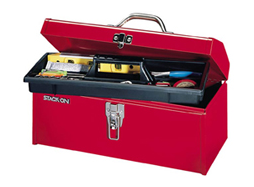Putting Together a First Toolbox
No matter what kind of job you are doing, having the right tools to hand makes it go so much more easily. Having the right tools for the job also keeps you safer, since using tools that are fit for purpose means you’re less likely to have an accident.

Saving Money
People undertake their own DIY projects for a number of reasons, including the wish to save money and the sheer satisfaction they get from completing a project with their own two hands.
It’s a mistake, regardless of your reason for undertaking jobs by yourself, to skimp on cost when it comes to buying tools. Those cheap spanners or that cut-price drill might seem a bargain, but good tools that will last you through several heavy-duty projects and beyond will always cost a bit more.
It’s a false economy to automatically buy the cheapest you can find. Not only are they likely to break or develop faults in very short order, but there is more chance you’ll do yourself an injury should the tool malfunction during use. As the BBC advises, you should always buy the best you can afford.
Good-quality tools, for instance, are an investment rather than an expense. They’ll reward you with years of good service, do the job they were designed and built to do and help keep you safe in the process.
Choosing Tools
If you’re new to handyman and you have put up your first shed, or have converted a garden room from online retailers like http://www.gardenspaces.co.uk/garden-rooms/garden-rooms/ and want to fill it with all the right tools to start your new adventure and undertake your construction tasks and are putting together your first toolbox, you may be wondering what you need to include. The Mail Online lists several tools to start you off, but here are some other suggestions.
A Saw
There are lots of different types of saw in different sizes and intended for different types of jobs and materials. For a basic saw, choose a multi-purpose one that will deal with most wood or plastic materials and which has medium-sized teeth. Add a small hacksaw for the more fiddly jobs or for cutting metal pipes or trimming window blinds.
A Hammer or Two
Very small hammers won’t tackle heavier jobs, and large hammers won’t do if you’re trying to hammer in tight areas. You’ll probably need a couple. If you’re undertaking heavy work, consider adding a sledge hammer to your arsenal, and make sure it’s a good one. Look for an indestructible handle copper head sledge hammer which not only has a tough head, but also a super-strong handle that can deal with mis-strikes or over-strikes without falling apart.
Screwdrivers
You’ll need several screwdrivers in different sizes and for both slotted and crosshead screws. You can buy them in sets, and it’s best to spend a little more. Very cheap screwdrivers wear out quite quickly
You will, of course, need many more items in your toolbox than those three, such as pliers, wrenches and spanners. Instead of buying everything at once, you can save money by making a list of the tools you’ll need for a specific job and then buy just those. You can add more later as other jobs crop up.


